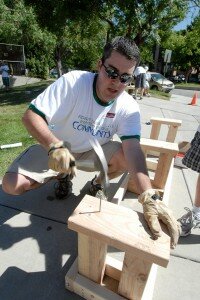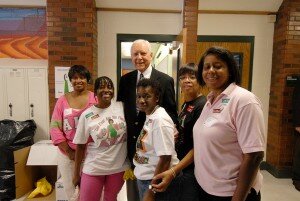 Yesterday we offered some tips for volunteering with schools. Today, we offer up some more tips for getting volunteer projects off of the ground. Have you ever planned a volunteer project in a school? Do you have any tips to share? Let us know in the comments!
Yesterday we offered some tips for volunteering with schools. Today, we offer up some more tips for getting volunteer projects off of the ground. Have you ever planned a volunteer project in a school? Do you have any tips to share? Let us know in the comments!
Use Community Resources
Schools are often short of resources. If you are running a sports program, arts club, or any other project that requires materials, you will probably need to solicit donations. Local businesses and restaurants may be willing to contribute. Community centers may have supplies or meeting space to share. Large projects can have fundraisers and donation drives to support their needs. The Volunteer Spot blog has some great ideas for fundraising.
Follow Through on Commitment
Once you start a project, teachers, staff, parents, and students will become dependent on your work. It is important to carry through with your promises and commitment. Never bite off more than you can chew and be honest about your time commitment and availability. If you begin to feel overwhelmed, remain open and honest with those you are working with and work together to seek a solution.
Evaluate Outcomes and Measure Success
As a volunteer, it is beneficial to evaluate your work and consider areas for improvement. Speak to teachers and school administrators beforehand to discuss appropriate benchmarks. There may be tangible measures of success such as improved grades (although some school policies don’t allow grades to be shared), test scores, knowledge level, or attitudes toward learning.
Or you could simply observe that you engaged a group of students, completed a large product, brought children safely to and from school, or filed a large stack of papers.
Recognize All Involved
 Throughout your involvement as a school volunteer, make sure to show appreciate to all those involved. This might include fellow volunteers, teachers, staff, or students. Below are tips:
Throughout your involvement as a school volunteer, make sure to show appreciate to all those involved. This might include fellow volunteers, teachers, staff, or students. Below are tips:
- Deliver recognition in a personal and honest manner. There’s no need to be disingenuous or to exaggerate someone’s contribution.
- Tailor your recognition and reward to the unique needs of the people involved. Have a variety of recognition and reward options available.
- Recognize contributions throughout the project – timing is crucial! Time delays weaken the impact.
- Have a clear message. Be sure that students and volunteers understand the criteria used to determine awards.
- Students can also be recognized through special certificates or small rewards such as erasers, pencils, journals, or rulers. (Note: toys and candy often become a distraction in the classroom.
The best way to recognize students and volunteers is to treat them with respect and give them support and praise throughout the project.
It’s vitally important to say thank you during the project and once the project is complete. Check out Eight Tips for Writing the Perfect Thank You Note
Reflect, Evaluate, and Move Forward
Reflection is strongly encouraged after every service experience. Reflecting as a group, with all the participating students and volunteers, can create a stronger sense of accomplishment and connection. This group conversation can often deepen student’s and volunteers’ understanding of the social issue your project addresses and increase their commitment to service and learning.
Here are some sample reflection questions to help facilitate a reflective discussion about the service project:
- What? What issue(s) was being addressed? What did you notice happening around you during the project? What were the results/outcomes of the project?
- So what? What did you think about during the project activity? How has it affected you?
- Now what? What are the larger issues that caused the need for you to participate in this service activity? How did your efforts help? What else needs to be done to improve these problems? How will you apply what you learned in the future?
In addition to reflection, it is important to evaluate the project. This means reviewing the effectiveness of the project components: the planning, coordination, delivery, implementation, logistics and management.
 At the end of a project, solicit feedback from students, volunteers, parents, and teachers. Feedback is a gift – use it as an opportunity to reflect on the overall management and implementation of the project. You can provide a feedback form (this is probably best if you are leading volunteers or students), or have less-formal conversations.
At the end of a project, solicit feedback from students, volunteers, parents, and teachers. Feedback is a gift – use it as an opportunity to reflect on the overall management and implementation of the project. You can provide a feedback form (this is probably best if you are leading volunteers or students), or have less-formal conversations.

 1. Determine What You Can Contribute
1. Determine What You Can Contribute

 8. Evaluate Outcomes and Measure Success
8. Evaluate Outcomes and Measure Success
 As some of you may know, HandsOn Network and Fidelity Investments are partnering in an amazing effort that is revitalizing the learning environments in 11 middle schools across the nation. In locations ranging from Nashua, NH, to Albuquerque, NM, Fidelity employees are working with HandsOn action centers and partners on local Transformation Days, executing projects chosen with each school’s teachers, students, parents, and community.
As some of you may know, HandsOn Network and Fidelity Investments are partnering in an amazing effort that is revitalizing the learning environments in 11 middle schools across the nation. In locations ranging from Nashua, NH, to Albuquerque, NM, Fidelity employees are working with HandsOn action centers and partners on local Transformation Days, executing projects chosen with each school’s teachers, students, parents, and community. The senator’s presence had particular resonance, since he and the late Senator Ted Kennedy were instrumental in passing the bipartisan Serve America Act last year. The Act is the greatest expansion of national service in many decades. Last year Points of Light Institute honored both senators with the Points of Light Lifetime of Leadership Award for Volunteerism and Service, recognizing their commitment and leadership in creating civic change through service. “Seeing individuals like you, working hard in the community…is what we thought would happen when we passed the Serve America Act,” said Senator Hatch to the volunteers.
The senator’s presence had particular resonance, since he and the late Senator Ted Kennedy were instrumental in passing the bipartisan Serve America Act last year. The Act is the greatest expansion of national service in many decades. Last year Points of Light Institute honored both senators with the Points of Light Lifetime of Leadership Award for Volunteerism and Service, recognizing their commitment and leadership in creating civic change through service. “Seeing individuals like you, working hard in the community…is what we thought would happen when we passed the Serve America Act,” said Senator Hatch to the volunteers.

